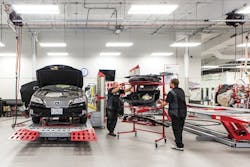With the influx of plug-in electric and hybrid vehicles in recent years, tapping into that market could be a new source of customer acquisition. According to studies, 7 percent of electric vehicle charging occurs outside the home. Installing an electric vehicle charging station is one way of getting those drivers to your shop.
Pat Cadam, owner of Pat’s Garage in San Francisco, has always been on the cutting edge of new vehicle technology. Four years ago, he installed an electric vehicle charging station that he says has helped his shop grow his customer base significantly.
Cadam discusses the process of adding an electric vehicle charging station to any shop.
I’ve been involved in alternative fuel vehicles for a while. We started working on hybrids when they first came out in 2000, so we’ve been involved in that arena for a long time. When plug-in electric vehicles came along, we got involved in that right away.
I realized there were some obvious marketing, customer retention and customer acquisition aspects that went along with having a charging station. We saw it as a tool to help us continue the process of doing projects on electric vehicles.
What I’ve found is that it expands the potential pool of people I can draw my customers from. If people know you have this charging station, it will bring customers to you that may not normally come to you. Even if they have an electric vehicle that doesn’t require a lot of work for the average shop, chances are it’s not their main car or the only car they have.
The process of acquiring a charging station is now very easy. First of all, you can just buy one. Even places like The Home Depot or Amazon sell them now. But it’s still early enough in the expansion of charging stations that, depending on how saturated your area is, there may be incentives or grants for a shop to put one in. I’ve had mine for almost four years and I got it under a grant. I got paid for the installation and the charge station was free. All in all, I only had to pay $1,000. However, if you purchase one yourself, the average charger will set you back roughly $2,000-$3,000.
Another benefit to installing one is that most auto repair shops already have enough electricity to make it happen. It’s a 240-volt system and a 40-amperage circuit. Most shops that have an air compressor or a welding machine probably have those circuits already in the shop. Any licensed electrician would be able to determine if the existing circuits would be large enough or need an upgrade.
There are three different levels of charging stations available: Levels 1, 2 and 3. Level 1 has the least amount of voltage and takes the longest to charge. Level 1 charging is the technical jargon for plugging your car into an ordinary household outlet. Level 2 supplies 240 volts and allows for a wide range of charging speeds. It is considered the standard charging station. Meanwhile, level 3 is a 480-volt circuit and takes very special wiring.
I went with a level 2 charging station. My charging station actually has two different levels of charge available on it: Levels 1 and 2. I like it because I can have two cars charging at once. Most charging manufacturers make these dual-circuit chargers.
Most of the charge stations you buy will be networked, which helps with any software updates or maintenance. Because of that, there is very little upkeep for me. The fact that it’s a networked computer also allows me to select how much I want to charge people to use it, if anything at all. For the first two years, I provided it for free because I was trying to encourage people to use it. Now, I charge 34 cents a kilowatt, which I chose because it allows me just enough to break even with any fees. The average car may take 10–15 kilowatts of electricity, so it’s still a very little cost for the customer.
It’s important to think about the positioning of your charging station. I wanted mine outside of the shop so it could easily be used by the community at large. That way, even non-customers could easily spot it and use it. I also have special signage right above the station that lets people know where the charging station is located.
My charging station is used nearly around the clock. Having one has a number of benefits. First, it makes you stand out in the crowd of shops in your area. It creates a very positive image in the community because it shows that you’re interested in technology and new things.
Second, it gives me a chance to get to know the drivers of the cars, their needs and to introduce ourselves and what we do. We have people charging for as little as 30 minutes up to half a day. Many people come into our offices and sit and chat with us. That’s a great opportunity to build a relationship and find a new customer.



